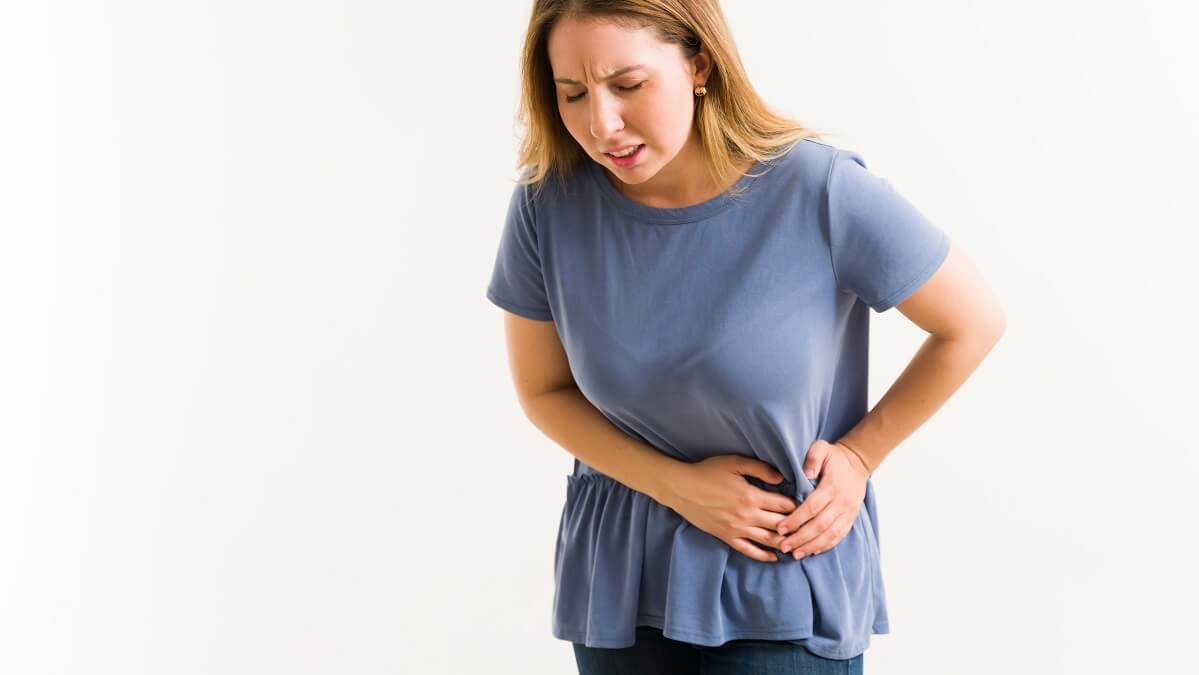If you have bad stomach pain, it’s easy to attribute it to bloating or indigestion. Your mind might even jump to appendicitis if it’s really painful. But there’s another health condition that can present as stomach pain, which may not be on your radar – a gallbladder attack.
You no doubt know you have a gallbladder but aren’t exactly sure where it is or what it does. Here we go through what the gallbladder does and the signs of a gallbladder attack.
Where is the gallbladder and what does it do?
The gallbladder is a small, pouch-like organ that sits under your liver on the right side of your midsection below your ribs. It stores bile, a fluid produced by the liver that helps break down fatty foods. When you eat, your gallbladder contracts and sends bile through ducts to your small intestine to help you digest food. This allows fat-soluble vitamins and nutrients to be more easily absorbed into the bloodstream.
Your liver still produces bile even without a gallbladder so, much like an appendix, surgery to remove it is quite common if you develop gallbladder problems.
What are gallbladder attacks?
A gallbladder attack, sometimes called biliary colic, happens when the ducts are blocked, and bile can’t get in or out. Too much bile in your gallbladder irritates it and causes inflammation and pain. Gallbladder attacks are known to be very painful.
Gallbladder attacks often follow heavy meals and usually occur in the evening or during the night. If you’ve had one, more attacks are likely to follow.
What are the causes?
Gallstones are a major cause of gallbladder attacks. These are little deposits of hardened digestive fluid that can range in size from a speck of sand to a golf ball. If you have gallstones, when your gallbladder contracts to try to push out bile, the deposits can get wedged inside the duct that goes to the small intestine.
Gallbladder attacks usually stop when gallstones move and no longer block the bile ducts. However, if any of your bile ducts stay blocked for more than a few hours, you may develop gallstone complications. Gallstones that do not block your bile ducts do not cause symptoms.
Other conditions that keep your gallbladder from working correctly can also cause an attack. These include cholecystitis (swelling and redness in the gallbladder), tumours, abscesses, sclerosing cholangitis (scarring of your bile ducts or gallbladder), abnormal tissue growth and chronic acalculous gallbladder disease, which keeps your gallbladder from moving the way it needs to in order to empty.
Common symptoms
A gallbladder attack usually causes a sudden gnawing pain that gets worse, it typically lasts for 20 minutes to an hour. These are the types of pain to look out for:
- sudden and rapidly intensifying pain in the upper right portion of your abdomen
- sudden and rapidly intensifying pain in the centre of your abdomen, just below your breastbone
- back pain between your shoulder blades
- pain in your right shoulder.
Other symptoms of a gallbladder attack
Jaundice can occur when backed-up bile enters your bloodstream and causes your skin and the whites of your eyes to turn yellow. You could experience a fever or chills; you might also vomit or feel nauseous.
Your urine may be the colour of tea and your faeces can be light or clay-coloured.
Increased risk of having a gallbladder attack
Your sex can increase your risk
Women aged 20 to 60 have a higher chance than men of developing gallstones. That may be due to extra oestrogen in the body from pregnancy, hormone replacement therapy, or birth control pills. After 60, though, men and women are at equal risk.
Your weight and diet also play a role
If your diet is rich in refined carbohydrates and high-calorie foods but lacking in fibre, you raise the risk of a gallbladder attack. Obese people are also more likely to experience a gallbladder attack than those of a normal weight
Unfortunately, quick or dramatic weight loss can also bring on an attack, for example, your risk increases after weight-loss surgery.
Other conditions that can raise your risk:
- cirrhosis (a disease in which your liver stops working because of disease or injury)
- infection
- sickle cell anaemia
- intestinal diseases such as Crohn’s disease that keep you from getting certain nutrients
- metabolic syndrome
- high triglycerides
- low LDL cholesterol levels
- diabetes.
When you should see a doctor
If you’re experiencing symptoms of gallstones, you should talk to your doctor as soon as possible, according to the Mayo Clinic. This is because gallstones and gallbladder attacks can get progressively worse if left untreated, and complications can even be fatal in some cases.
Treatment for gallbladder attacks
Treatment depends on whether you’re having a regular gallbladder attack or are experiencing gallstone pancreatitis. To figure out what’s going on, your doctor will likely do an imaging test such as a CT scan or ultrasound; tests to check the state of your bile ducts; blood tests, or use a thin, flexible tool known as an endoscope to evaluate your stones.
If it’s found that you have gallstones blocking the way to your small intestine rather than to your pancreas, they’ll likely try to remove them with an endoscope or remove your gallbladder.
That might sound startling, but gallbladder removal, or cholecystectomy, is common and, as mentioned, you can live your life normally without your gallbladder.
Have you had your gallbladder removed? Have you ever experienced a gallbladder attack?.
Also read: Signs of a damaged liver
Disclaimer: This article contains general information about health issues and is not advice. For health advice, consult your medical practitioner.

